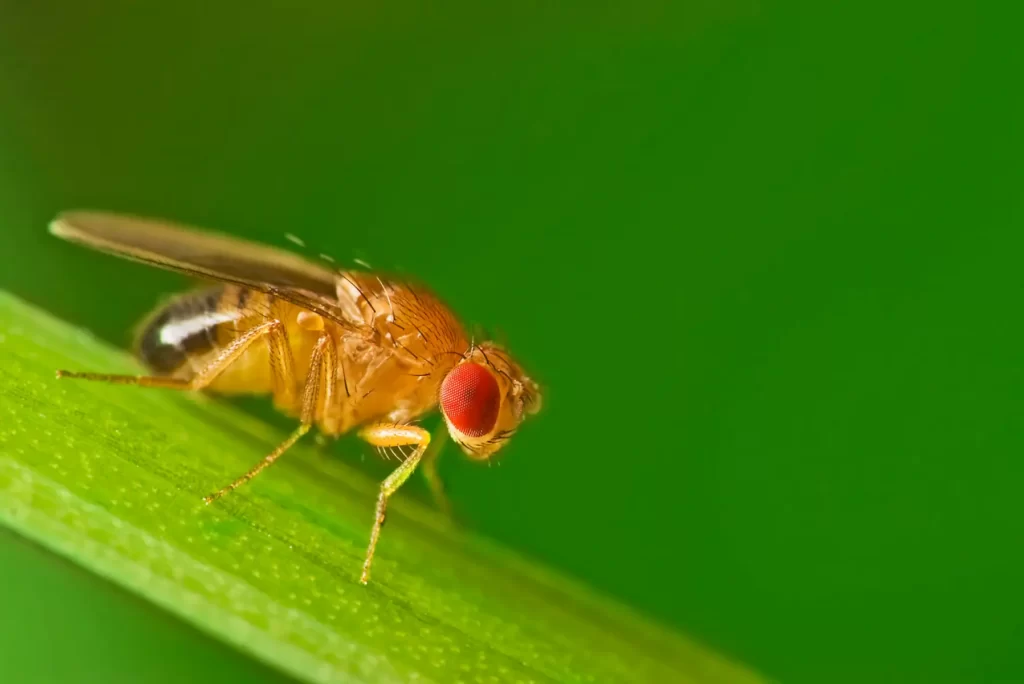Last Updated on July 10, 2023 By Emma W. Thomas
Flies often exhibit a behavior known as “fly looping” or “circular flight” when they appear to fly in a square or circular pattern in the middle of a room. There are a few reasons why flies may engage in this behavior: searching for an exit, following airflow, territory establishment, mating behavior, etc. Some theories also claim that only male flies circle in the middle of a room to attract females.
This article looks at some common fly behavior and explains why they do those things. It also takes you through the types of flies and their flying patterns and behavior. You will also get enlightened on some interesting facts about flies that you might not have heard of and answer common questions. Let’s get to it!
Why Do Flies Fly In A Square Pattern In The Middle Of A Room?
There are a few reasons why flies may engage in this behavior:
- Searching for an exit: Flies have a strong tendency to move toward light sources. When inside a room, they may perceive windows or openings as potential exits and attempt to reach them. The square or circular pattern may be a result of their attempts to navigate and find an escape route.
- Following airflow: Flies are sensitive to air currents and may be drawn to areas with better air circulation. In the middle of a room, there might be air movements that attract them, such as drafts from vents or fans. The square or circular flight pattern can be a response to these airflow cues.
- Territory establishment: Some flies, such as male fruit flies, engage in territorial behavior. They might fly in looping patterns to mark and defend their territory against other flies. This behavior is more commonly observed in smaller spaces like fruit bowls rather than larger rooms.
- Mating behavior: In certain fly species, males perform elaborate courtship displays to attract females. This can involve flying in specific patterns or performing aerial maneuvers. However, this behavior is less likely to occur indoors in the middle of a room.
It’s important to note that fly behavior can vary depending on the species, environmental conditions, and individual circumstances. While square or circular flight patterns are occasionally observed, flies may also fly in straight lines or erratic paths in their search for food, mates, or suitable environments.
Which type of fly flies in square patterns?

The lesser fly, also known as the little house fly, has the behavior of entering a building or room and starts to fly around in square patterns in the middle of the room. Some of the characteristics of the lesser fly are:
- It is smaller in size when compared to the common housefly.
- It is quite slender
- It has a straight median vein in the wings
- They feed on decaying matter
- They have a length of between four to six millimeters.
The male and female lesser flies have slight differences in appearance. The table below summarizes the differences.
| Male Lesser fly | Female Lesser fly |
| Their eyes are white-bordered and tend to meet above. The condition is known as holistic. | Their eyes do not meet |
| They have a brown-grey thorax with three longitudinal stripes | The longitudinal stripes are less distinct. The first two segments on their abdomen are yellow and have a dark basal color. |
| They have dark trapezoid marks | The trapezoid marks are less distinct |

Development of the lesser flies
The development process of the lesser fly is similar to all other species, including the common housefly. The female flies lay eggs in batches of 50 up to 2000. These eggs are white and have two dorsal longitudinal wings, and can float in liquid and any decaying organic matter.
Behavior
These flies are spread worldwide and have a short life expectancy of two to three weeks. Lesser flies like moving around food, and due to their interaction with dirt and germs, they are disease carriers.
They are seen to have increased in number from May to October. You will notice their silent flights in the room’s center during this time. They also like circling down mainly on hanging items such as lamps. Their flight directions are not static and can change from time to time.
At night, when they are not flying around, they sit on lamps or on the walls, where they excrement marks.
What is the scientific classification of the lesser housefly?
Scientists can group and distinguish various organisms according to scientific groups. Studying them becomes much easier once the organisms are placed in these groups.
| Kingdom | Animalia |
| Phylum | Arthropoda |
| Class | Insecta |
| Order | Diptera |
| Family | Fanniidae |
| Genus | Fannie |
| Species | F. canicularis |
The Binomial name for the flies is Fannia canicularis.

Interesting facts about flies that you did not know
Flies remain to be a nuisance to many people. Their buzzing dirty legs and aimless flying are too much to handle. They also have some interesting behaviors and adaptations that are not so obvious.
The following facts about flies are just mind-blowing.
Flies live on a liquid diet
Yes, you read that right. Flies have a diet, which is mainly composed of taking liquids. They naturally lack mouthparts. They cannot chew and are hence forced to drink.
How they eat
Let us keep in mind that flies cannot chew. They have to drink. To eat, they have to produce some digestive juices and enzymes onto the foods they want to consume. The juices and enzymes help replicate the food from its solid form into smaller pieces for the flies to get their drink.
Flies can taste through their feet
Butterflies are not the only ones capable of tasting using their feet because flies can also do that. They have taste receptors on their lower legs and feet. When they land on what they term as food, this can be garbage, manure, trash, or even well-cooked food. Just imagine the number of germs and dirt flies collect as they move.
Flies defecate a lot
Defecating is not the issue. The cause of the alarm is that they can defecate anywhere and have no control over it. Living off a liquid diet makes their digestive system very fast this is why they defecate often. It is said that houseflies defecate every time they land. Just picture how many times you have consumed defecated food.
Flies can walk upside down
Most people have seen this, but not everyone has. A housefly’s anatomy enables it to either walk or climbs on surfaces no matter the direction of the surface. A surface can be vertical, upside down, or even horizontal, but a fly will be able to climb and walk on it.
Each housefly’s foot has a pair of flat foot pads containing tiny hairs which produce a glue-like substance. The glue-like substance is composed of sugars and oils that give the housefly’s the grip they need on surfaces.
Flies can see behind them
How many surprise attacks and pranks would you be able to know of if you could see what was happening behind you? The answer is many. Flies are privileged to have the ability to see what is happening behind them.
Flies have compound eyes, which offer them a 360 field of view. Their eyes do not also move. With this ability, they navigate well and can also lookout for danger.
They have a short lifespan
Their life cycle goes for around 30 days. However, the short life span does not limit them because they still lay plenty of eggs in that period, making sure they leave behind other flies when they die. Acquiring life and giving life in thirty days is unbelievable.
They have fantastic reaction times
They have excellent agility skills and quick reaction times. This enables them to react very quickly to what they see. Human beings can process sixty images in a second, but flies can process 250 in a second. This ability makes it very hard for the flies to be captured quickly.
Flies have unhygienic breeding habits
They have interesting breeding habits; they look for a dirty environment to lay their eggs.
Flies lay eggs on decaying matter, manure, and even human wastes. Why do they do that? They provide the larvae or the maggots with food once they hatch. It is a means of making sure the young ones survive.
Male house flies are always looking for a date match
You earlier read that the flies have compound eyes, right? Studies show that the males have a region in their eyes where the love spot is found. They use this region in their eyes to detect, locate, and even chase female flies. This region is in the dorsofrontal part of the eye. Apart from finding females, the spot also helps them detect small and sudden motion that is not easily noticed and stay put or locked on their mates during an aerial pursuit.

Frequently asked questions about flies
- What are flies most attracted to?
Flies are primarily attracted to filth, garbage, human and animal wastes, organic and decaying matter, and rotting meat. Fruit flies are attracted to sugary substances.
- How many eyes do flies have?
They have two compound eyes. The two eyes are equivalent to very many eyes.
- Can flies hear?
Yes, they can. They have very tiny ears at the front of their thorax, below where the head and neck attach.
- Do flies have teeth?
No, they do not. They do not chew food, and their mouthparts are compared to spongy straws.
- What are flies scared of?
Flies hate certain smells. These smells are; peppermint, basil, pine, rosemary, rue, bay leaves, eucalyptus, and lavender.
- Do flies have blood?
No, they don’t. However, they have some liquid in their body that serves the function of blood. It transports nutrients, wastes, and hormones. They also have a heart near their backs.
Final word
Flies can be very irritating. With proper methods, you can control them and even prevent them. We must practice good hygiene to avoid these flies, which are the leading causes of diseases, germs, and dirt.
References:
https://en.wikipedia.org/wiki/Lesser_house_fly
Emma is a graduate of Domestic Science or Family and Consumer Sciences (Home Economics) from the University of Wisconsin. She has 7 years of experience Working with the strategic section of BestBuy and now writing full-time for Homeeon.
From Managing the Home, Interiors, Cleaning, and Exteriors to Gardening and everything about Making A Home Liveable – is her passion and this Homeeon is the result of this.
Emma loves decorating her home with the best stuff found online. She cares about quality over anything and writes reviews about them here in Homeeon. Get in touch with her over Pinterest.
Keep reading her blogs.

